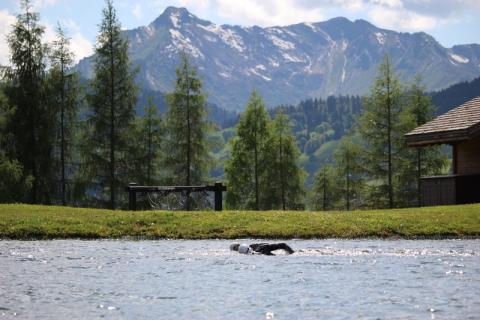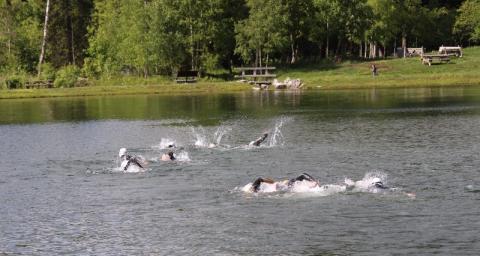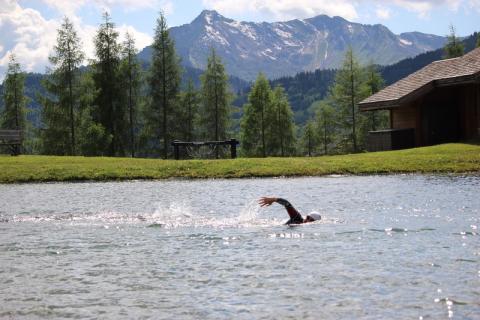Nailing your open water swim: our top 10 tips
16th April 2018 - 19:30
With the weather (finally!) warming up here in the UK, many of you will now be contemplating ditching the pool for open water. With that in mind, Matt Sanderson, coach and co-founder of Triathlon Coaching UK, has put a few tips together to help you nail your open water training and racing this season.
"I'm sure many of you have been ploughing up the pool lanes and dodging the non-swimmers in the fast lane during the winter months. With spring now on us, we can now start to make preparations for the open water season.
With this in mind, here are my ten key components of what makes a good open water swim technique. I’ve started with three points commonly missed by athletes even before they have stepped foot in open water, but every point can contribute to ensuring you have an enjoyable and effective swim.
For some, the first thoughts of performing well in open water are when they are already in the dark waters of a lake. My advice is to start your preparations for every open water swim from dry land before you enter the water.
1) Mental preparation: Many an open water swim has been ruined by an athlete rushing into the water without thinking about the environment they are about to enter. Take some deep breaths and map out your route around the course you are going to swim. Mentally break the course up into distances between buoys and then equate that into the number of lengths of a pool to give you an easier understanding of the actual distance. Now think how you would approach that swim if it were in a pool. Use this time to take in some deep breaths and positive visualisations of swimming with relaxed and effective technique.
Once you have calmed your thoughts spend a couple of minutes thinking how you might deal with other less predictable scenarios should they arise. For example: How will I react should I take on water and struggle to get my breath?
In your mind you tell yourself you will simply relax your breathing, slow your stroke rate and re-find your rhythm again and that within no time you will be relaxed and comfortable again.
While thinking of less comfortable scenarios might make you feel a little uneasy it is good practice to find an answer to each as you can then draw from that should you ever experience it. Just make sure you finish your mental preparation with positive thoughts!

2) Physical preparation: Take time to get your suit on correctly and high enough so not to hinder range of movement especially around the shoulders. The suit should fit snug in the crotch with no rolls around the back of the knees. Get the legs right before starting on the upper body. Once the suit is on you are ready for another dynamic warm up. Now is time again to mobilise the joints, raise the heart rate and physically prepare the body for exertion. Don’t go into the water with a low heart rate and then expect to feel good when the heart rate jumps 50-60 beats in the next 2 minutes! Perform 10 squats, 10 arm swims, 10 spinal rotations, 10 knee hugs (5 each leg) a couple of times through before entering the water especially before a race start - even if you plan to just ease your way into the swim.
3) Be ready for dark, cold water! Unless you are swimming in places like Bussleton for IM Western Australia where you might see an octopus or two sat watching your swim from the sea bed then the water you are swimming in will most likely be a dark green colour, colder than the pool you’ve been used to and you will be lucky to see your own hand in-front of your face! This is reality and the sooner you convince your brain that this is normal the better. Always try to get in the water prior to the race start and get your face in the water and slowly exhale into the water to help relax you and prepare you.
For many new OW swimmers there is a tendency to hold onto the breath underwater which can lead to hyperventilation and anxiety. Focus on breathing out when your head is in the water - practice this with the ‘breathe, bubble, bubble, breathe’ drill where you audibly say the words ‘bubble, bubble' on each stroke before taking a breath in on the third stroke. This encourages you to exhale in a relaxed manor allowing you to focus only on breathing in when turning to breathe.
Once in the water there are a number of key skills to develop to make your open water swim both effective and enjoyable:
4) Swim straight lines: focus on swimming straight lines more than swimming fast. With a wetsuit to help your buoyancy swimming should be quicker and less effort for most AG triathletes. Unfortunately many triathletes have poor navigation skills and often once they study their Garmin file they find they swam 10% further than they needed to! To help with this you should focus on breaking the swim down and swimming from one buoy to the next rather than looking too far ahead. You can also improve your ability to swim straight lines with the following point…

5) Be a versatile swimmer: In open water you need to be able to react to the conditions around you. If you can breathe to both sides at will and breathe every second, third, fourth or even fifth stroke with ease then you are a more versatile swimmer with more ability to adapt to the environment around you. If you only breathe to one side you might come unstuck if the wind is blowing water into your face as you attempt to breathe. To prevent this, be resilient in training and try this breathing technique, Breathe every second stroke, third stroke, second stroke, third stroke in sequence to help develop your ability to breath and sight all around you at ease. It will take some practice but is a really useful drill we use with TCUK athletes in preparation for OW swimming. Once mastered add in sighting every 5-6 strokes. Many of the leading ITU swimmers swim with a 2-3-2-3 breathing pattern. It is also a useful hybrid breathing pattern for those who feel they need to breathe more frequently than every third stroke but want to get away from breathing to one side only.
6) Develop a relaxed straighter arm recovery: a well fitting wetsuit allows for less restriction in the upper body and a more desired straighter arm recovery suited to open water swimming. A straighter arm recovery places less resistance into the neoprene and is less likely to tangle with other swimmers and also stays clear of choppy water allowing for a more effective hand entry and catch set up.

7) Sighting every 5-6 strokes in the pool & open water: in our swim analysis sessions we notice the breathing stroke to be the culprit of poor technique for many swimmers. Breathing and sighting often come hand in hand in open water. If the techniques are poor then the head will often lift too high, subsequently the legs drop as a result, the heart rate increases and swimming becomes more of an effort. When sighting, think of a Sir David Attenborough documentary and practice your ‘crocodile eyes’. The croc’s eyes are just above the water, high enough to see what is happening but not too high to reveal itself. For a swimmer this low profile can prevent the legs from dropping and reduces drag.
8) Find a good pair of feet to draft: Depending on your swim ability and pace this can be a great way of swimming fast and staying fresh - but beware - it can also lead to disaster! Chances are if you are swimming sub 1.30/100m you can trust the feet in front of you are a well trained pair and more likely to swim in straighter lines - just don’t rely on that being the case! If however you are following a 2.00/100m swimmer then their swim ability might not be as advanced and their experience in open water might be less than a more accomplished swimmer. Again, not always the case and many so called ‘slower’ swimmers finish higher up the rankings simply by swimming in straighter lines than quicker swimmers. If you are drafting then aim to stay close to the feet in front of you without tapping the toes of the swimmer. If you tap their toes frequently you will most likely annoy and frustrate them meaning they will be distracted, causing spikes in swim pace, changes of direction, and more chance of a kick in the mouth for you as they kick harder! None of which will help your swim!
9) Find open water: If your stroke is long and stroke rate is slow then you may be better suited to finding more space and undisturbed water to allow you to find your own rhythm. If you have a tendency to ‘over glide’ in your stroke then you should work on this in training with a Finis tempo trainer and lift your stroke rate slightly during your swim sets to reduce the dead spot in your stroke. Finding your ideal stroke rate is different for everyone but as a general rule a slightly choppier, quicker stroke rate transfers better into open water, especially in tidal swims. To find your ideal stroke rate ask your coach to take you through a ‘stroke rate ramp test’.
10) Experience open water before racing: this sounds obvious but I’m always amazed that people do their first OW triathlon without experiencing a coached session in open water before race day. Last year I attended a race where the last person out of the swim hadn’t swum in open water before and hadn’t even brought a bike to the race, intending on hiring one when exiting the swim! There was a happy ending to the story thanks to very accepting marshals but this lack of preparation when swimming in open water could put lives at risk - please encourage your fellow triathletes to be prepared for open water."